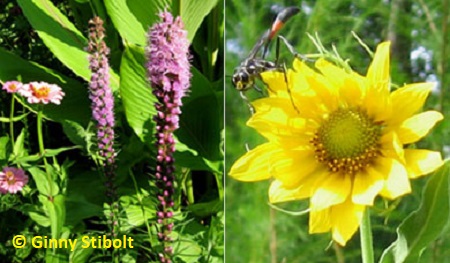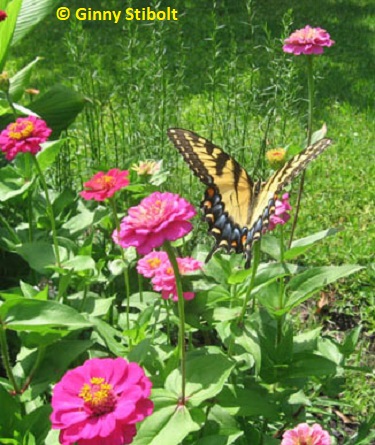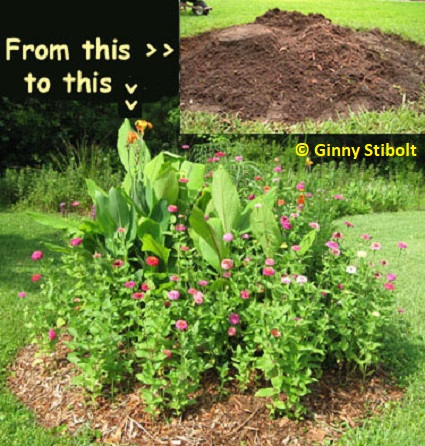Adventures of a Transplanted Gardener |
|||
From stump to butterfly haven
|
 |
<< Two blazing star stalks, on the left, blend in with the zinnias' colors and attract their own set of pollinators. The Maximillian sunflower on the right provides late summer height and clear, strong yellow.
This year I replanted zinnias and have added several native blazing star bulbs (Liatris spicata). I also planted some red hot pokers (Kniphofia uvaria), which are native to South Africa, but they haven't really taken off. Most of the plants I've purchased were chosen for their habitat value for butterflies and hummingbirds in the garden. While the soft rushes don't add much to the butterfly habitat, they volunteered along the lower edges of the mound and provide a year-round vertical structure.
 |
A female* eastern tiger swallowtail butterfly (Papilio glaucus)
pauses for a drink on a zinnia. Its caterpillar probably ate leaves
on some nearby choke cherry trees (Prunus serotina).
Surprisingly, hummingbirds also visit the zinnias. >>
Ongoing maintenance
One reason for trying a broad selection of perennials is to have an easier and more dependable way to provide good variety for the butterflies and hummingbirds. Each year they should continue to grow without my intervention. While zinnias are easy enough to grow, each year they need to be replanted. I'd like to get to the point where all that's required is a quick mulching each year and voilą-a butterfly and hummingbird paradise.
I hope you will turn an ugly (or hard to maintain) piece of your landscape into your own butterfly habitat. I think you'll find it rewarding as we do. My words don't do justice to the fluttering beauty on butterfly island from April to December.
* You can tell that it's a female eastern tiger swallowtail because of the blue spots on the lower sections of the wings. The male is yellow and black, too, but doesn't have the blue. The female could also be mostly black with the blue areas in the same place on the wings. This is called the dark phase and is more common here in its southern range. Maybe some of the dark swallowtail butterflies that I thought were spicebush swallowtails were actually the dark phase of this tiger. Hmm... I'll have to look at some of those photos to look for the ghostly stripes hiding in the black.
(Update: Some years later, this butterfly haven became blueberry hill.)
Resources:
· Tiger swallowtails: http://en.wikipedia.org/wiki/Papilio_glaucus
· Butterfly gardening in Florida: www.nsis.org/butterfly/butterfly.html
· "Florida Butterfly Gardening" by Marc C. Minno and Maria
Minno published by University Press of Florida. Click here to
purchase
it on Amazon.
Ginny Stibolt is a life-long gardener, a botanist, a naturalist, and a garden writer. You may contact her or read more of her articles posted on her website: www.greengardeningmatters.com.
Copyright Ginny Stibolt


